After a spell with Genoa, the Croatian coach Ivan Jurić was named the new manager of Hellas Verona in the summer of 2019. He had the difficult task of building a team that would resist the pressure and keep their place in Serie A, after an unsuccessful run in the 2017/18 season when they got relegated.
What seemed like a hard goal to achieve, ended up with fighting for a European football spot and then finishing 9th in Serie A last season with 34 points less than the champions Juventus, showing an intriguing style of play and consistency that they have lacked before.
The 45-year-old manager built a team that has its flaws but shouldn’t be underestimated since their approach was well-balanced and focused on exaggerating the players’ abilities.
In this tactical analysis in the form of scout report, we will examine Verona’s tactics and see how they looked prior to the new 2020/21 season. We will use analysis to see what are the areas that they need to improve on in order to keep their consistency and fight for even better performance.
Formations and squad
Verona, like quite a few teams in Serie A last season, heavily relied on their back-three strategy. The formations that Jurić most frequently used were 3-4-1-2, 3-4-2-1 and 5-4-1.
Their positioning on the pitch though isn’t so clearly defined as a 3-4-2-1. The coach had to adjust to his players’ strengths and has dropped the frontline deeper, right in between the attacking midfielders, while the whole team is highly positioned, often starting their build-up around the central line.
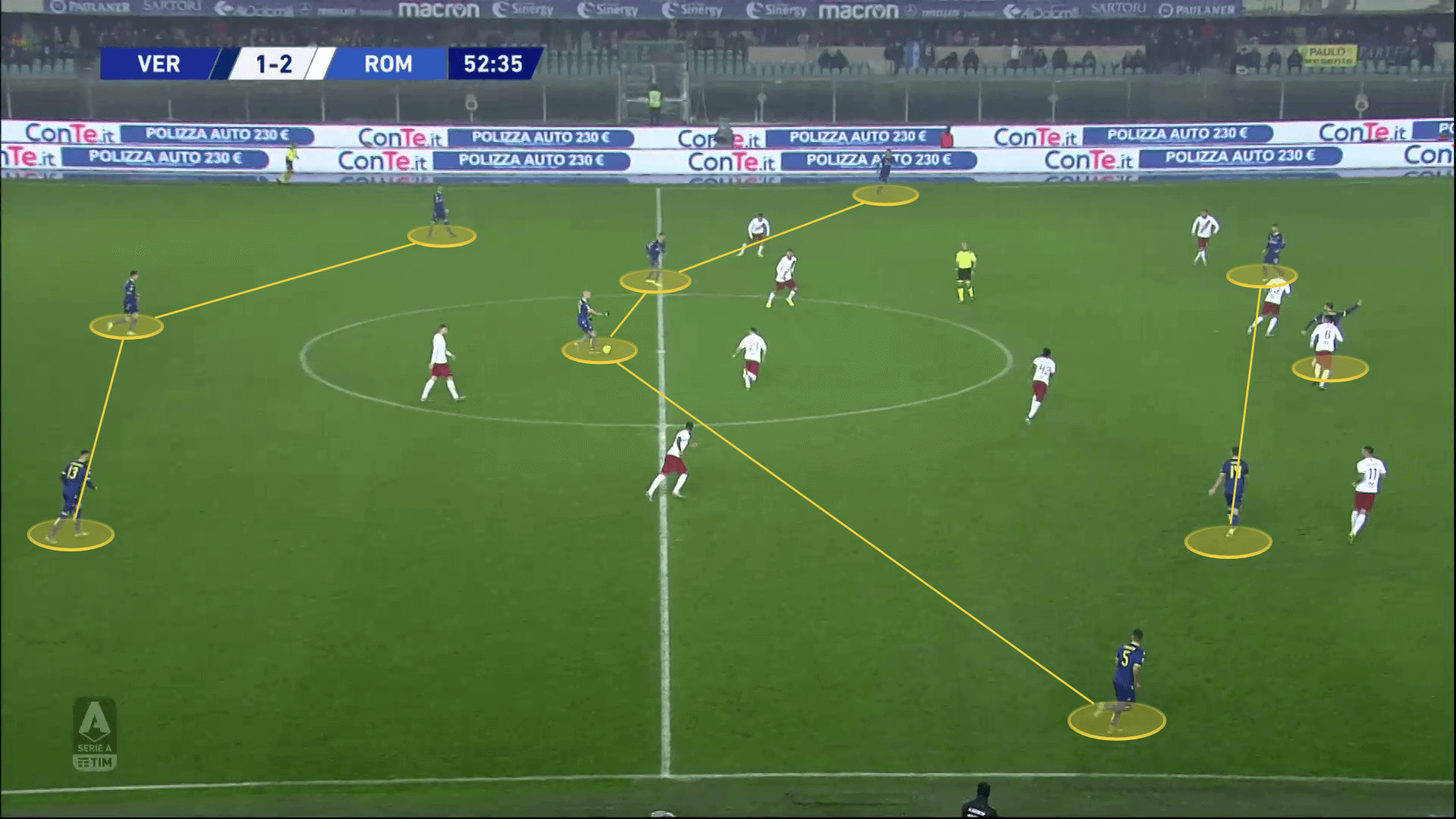
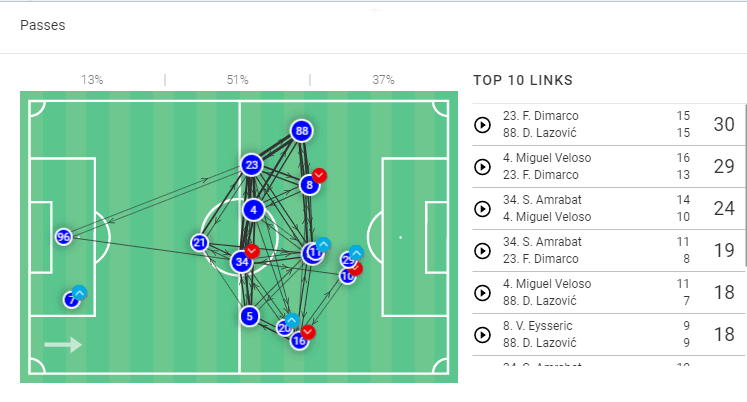
They usually use the centre-defenders for circulating the ball and retain possession who would then either spread out to the wing-backs who have a very active role in transitions or send it centrally to the central midfielders who would use their passing abilities to deliver it further. Their contribution to the ball progression and the attacking actions is crucial for Verona’s performance in the final third.
The lack of quality options on a few positions has forced Jurić to look for alternative approaches but also made him focus on the areas where he has solid performers in order to create a winning strategy. He managed to create a balanced-out performance despite the defensive vulnerability that comes with Verona’s defensive shape.
The team are more versatile when it comes to attacking approach and had a lot of the players putting efforts into the forward actions. The coach couldn’t find the perfect fit for the frontline, trying out different options but failing to find a consistent goalscorer who the team could rely on.
The coach tried to transform this disadvantage into an advantage and used that as an opportunity to bring unpredictability since a lot of the players were focused on the attacking ventures and they were trying to create opportunities from different positions.
The new 2020/21 season might be a tad more difficult for the coach though. Some of their players impressed with their performance and immediately caught the eye of the fellow Serie A teams, which saw Hellas lose some of their key figures.
While Verona have quite a few defensive options, he had a pretty consistent three-men defensive line, consisting of Amir Rrahmani, Koray Günter and Marash Kumbulla. Rrahmani is no longer part of the team since he joined Napoli after a deal for 14M in January and while Günter just signed a permanent deal finishing his loan spell from Genoa.
Rrahmani’s absence could affect Verona’s performance since he was an important part of their actions in the different phases. While there are a lot of players to choose from, it will take some time to adjust and find the right replacements, especially having in mind a high percentage of their possession circulates between the centre-defenders who actively contribute to the ball progression. They did immediately take actions bringing in two loanees, Mert Çetin from Roma and Giangiacomo Magnani from Sassuolo who are yet to prove their abilities.
When it comes to midfield, the double pivot in the centre will also have to change since Sofyan Amrabat joined Fiorentina leaving the 34-year-old Miguel Veloso as the main responsible for Verona’s transitions through the central areas. While Veloso ended up as the highest-rated player last season, helping in attack with his movement and flair, Amrabat was the one to help with solid passing, smart movement and strength. The team are reportedly securing some new additions to the midfield line, but they are yet to make it official.
The loanee Matteo Pessina, who scored seven goals, also got back to his parent club Atalanta and his future is yet to be decided, although Milan are said to have interest in him.
Ball progression and the use of the wing-backs
Verona’s build-up shape is quite intriguing. It starts off with the defenders but what makes the difference is that the back-three doesn’t stay in a line when in possession. Instead, one of the defenders stays deeper at the back, while the other two join the double pivot in the central midfield, allowing the wing-backs to settle in more advanced positions. This creates an overload in the opposition half and between the lines in aim to progress the ball and deliver it to the more advanced areas.
The right wing-back Marco Davide Faraoni was a crucial part of the team’s ball progression efforts. He would stroll up and down the flank helping in transitions, bringing balance between the lines, although it is his smart movement and late runs to the box that made him an irreplaceable part of the team’s attacking efforts. He would not only provide width with his positioning but would also occasionally cut inside and create chances in the central areas which increased their efficiency in front of the goal.
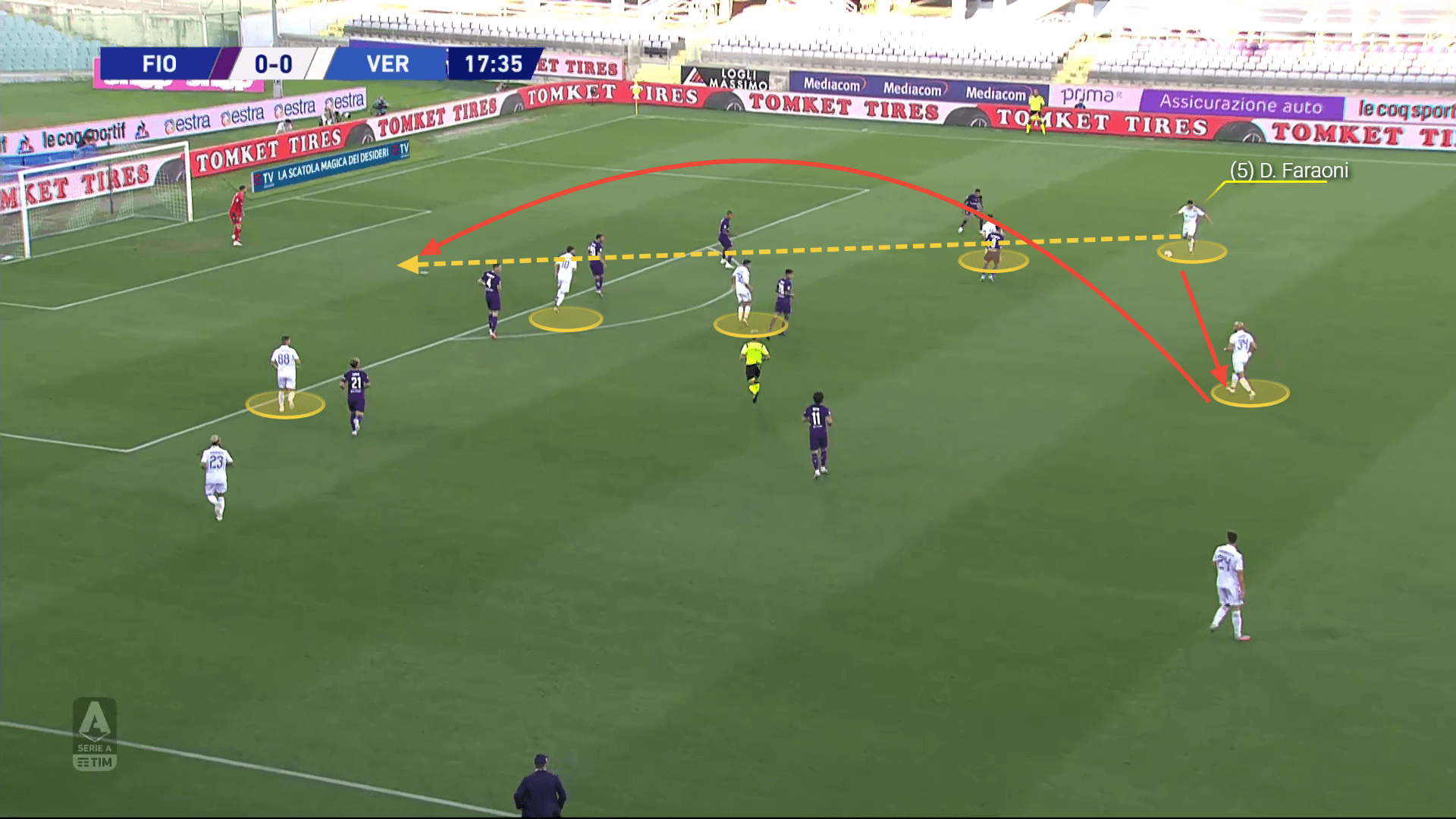
When it comes to the left, where most of the actions took place, Darko Lazović would join the attack and often act as a winger due to his high positioning. He was key for their final third actions due to his crossing abilities which saw him provide seven assists last season. He would also offer a direct threat due to his ability to shoot from distance, often moving into the half-spaces and trying to shoot from there.
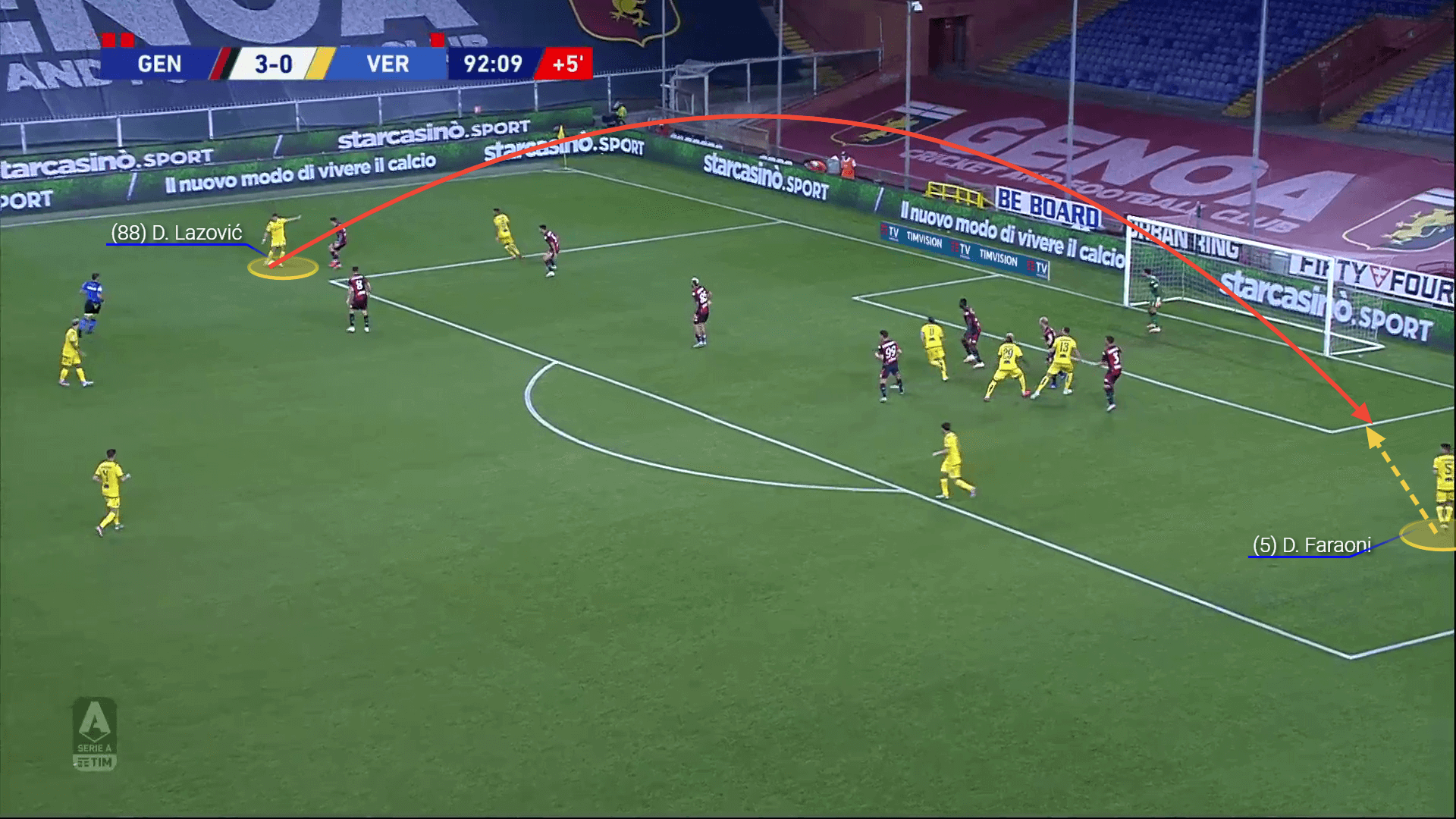
The double pivot in the centre were responsible for opening the passing lanes and helping to bypass the press using their smart movement, ball control and physical strength. They were key passing outlets during the build-up when the team aimed to break the lines and advance the ball in an efficient manner.
Attacking style of play and movement
Data-wise, Verona’s attacking performance wasn’t very convincing. The lack of a natural centre forward with clearly defined role made it hard for them to take advantage of some of their opportunities although it allowed them the freedom to move around and be creative, especially with exploiting free spaces. Due to the multiple players having the responsibility to threaten the goal, they tried to seek for the tiniest spaces and use intelligent movement to be able to create chances.
For creating their attacks, they tend to use the left flank most frequently by spreading out to the wing-back and creating attacking triangles relying on a lot of link-up-play between the wing-back, the left centre midfielder and one of the attacking midfielders.
Although Verona are the team with the fewest scored goals in the top 12 of Serie A (47) they did show creativity throughout the season and built some successful traits.
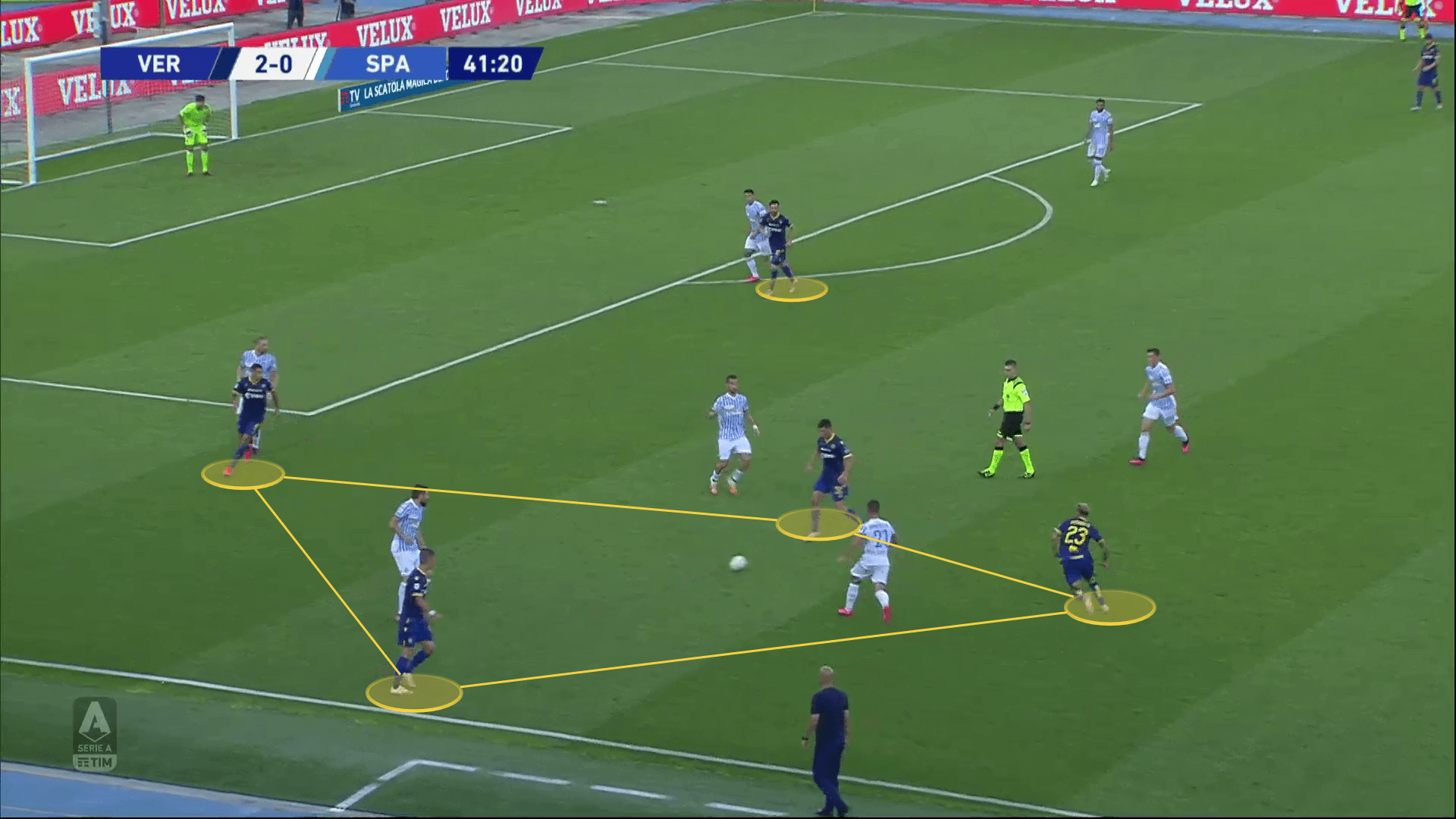
Their smart exploitation of the half-spaces allowed them to break defences and create chances successfully. Thanks to committing more players to the attacking actions and their link-up-play abilities they have managed to score some goals result of impressive team efforts. While it could insist more efforts to not have a natural lone striker who can convert the chances into goals, it could be rewarding since providing a threat from different areas could totally break the opposition’s defensive lines and nullify their marking strategy.
The team rely heavily on their crossing efforts, although, their attempts from the right aren’t nearly as successful as the ones from the left. While Lazovic is responsible for supplying his teammates with quality balls, Faraoni would exploit the areas in and around the box and provide an additional threat. The attacking-midfielders would be used for late runs to the box and as passing outlets in the advanced areas.
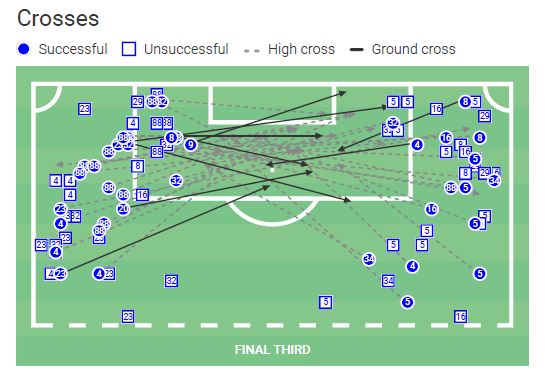
The team also tend to play on a counter a lot. With performing 3.03 counter-attacks on an average per game they often try to use their pace outrun their opponents and create chances. They tend to use a lot of movement in these efforts too and always rely on short pass combinations to advance the ball quickly. What’s impressive is that usually many of the counter-attacks end up with 1vs1 situations, while Verona have all of the players running forward, wanting to create numerical superiority. This is not only important for stretching the defence, but also provides a lot more opportunities in front of the goal, especially with second balls or reflected shots.
The team have been successful during attacking set-pieces too. Their corners often result in creating goalscoring chances, again thanks to their smart placement, spatial awareness and aerial performance. What’s interesting is that they often try to use their throw-ins as ways to threaten the goal. The strategy of positioning smartly and throwing the ball directly to the key areas has earned them some good chances throughout the season. They scored eight goals from set-pieces, while their measured actions in challenges have earned them quite a few penalties that resulted in scoring eight more goals.
Defensive style of play
The team would occasionally try to counter-press and win the ball back immediately while still in the final third, but when their efforts would fail, they were even more vulnerable due to their high positioning. That’s why their main strategy was the attacking players to join the team back and defend with more bodies.
Expectedly, out of possession the wing-backs would drop and support the defensive line while the double pivot would also drop deeper as additional bodies. Contrary to their attacking actions their movement during defensive transitions wasn’t that well executed. Lazović wasn’t as active defensively as in attack, which didn’t help the team in their transitions. They would usually try to cover the central areas, limit the space between the lines and force the play out wide, although this wouldn’t be the best strategy, since they were prone to concede more crossing attempts, meaning being exposed even more since their defending in the box wasn’t very organised. Their initial strategy would also fail due to their heavily man-oriented marking which will often engage them in certain areas and leave big gaps in others.
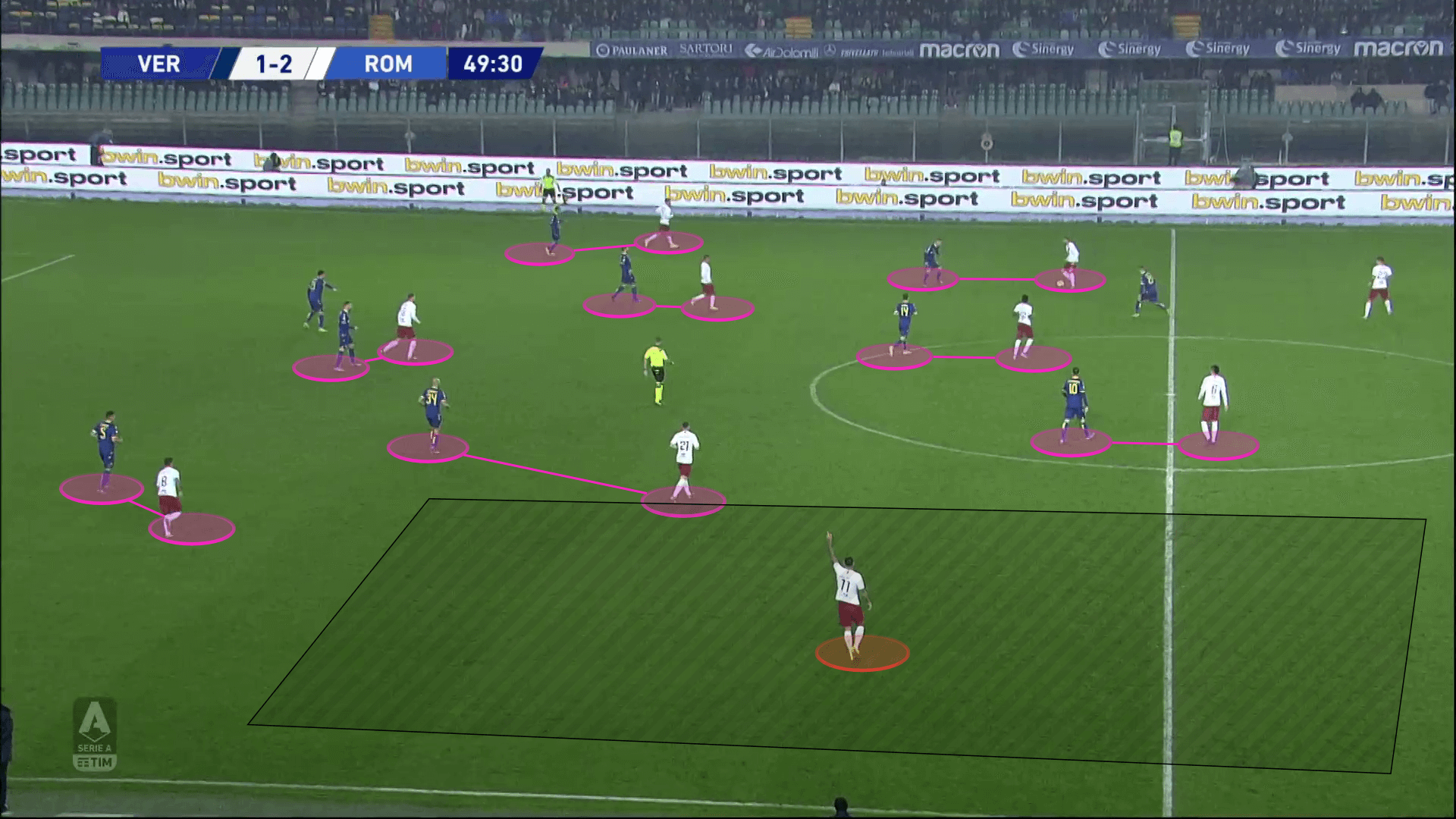
They would often dive in challenges and commit unnecessary fouls, which resulted in giving away penalties and conceding nine times out of these situations. What made them even more vulnerable is their inability to defend set-pieces. The marking strategy failed on a lot of occasions and let their attacking efforts go to waste due to the lack of awareness. Strangely enough, despite their solid aerial performance in attack, they often fall victim to lost aerial duels in the box. The team conceded 10 goals from set-pieces due to poor positioning and actions in and around the penalty area.
Areas for improvement
It is expected that Verona would look quite different going into the new season, with all the player movement that took place in the summer break. They still have time to bring new additions to the squad which makes their 2020/21 season even more unpredictable.
Despite the uncertainty, the team definitely need to find the best partnership upfront, since even though their attacking strategy has been rather successful than not, they need a forward with solid work under pressure and strong decision-making in front of the goal in order to be able to capitalize on their chances even better.
They do need to improve their reactions at the back too, starting off with their positioning and actions during set-pieces to their overall marking strategy and structure. If they manage to force the opposition to the areas they feel most comfortable defending in, they will immediately improve their defensive record.
Conclusion
Jurić might be the right person to build a tactically well-educated team with consistency and exciting style of play should they give him some freedom on the transfer market and some time to implement his vision. A lot of it, depends on the player’s capabilities and finding the right partnerships but one thing is sure, Verona became an interesting team that everybody should keep an eye on.






Comments